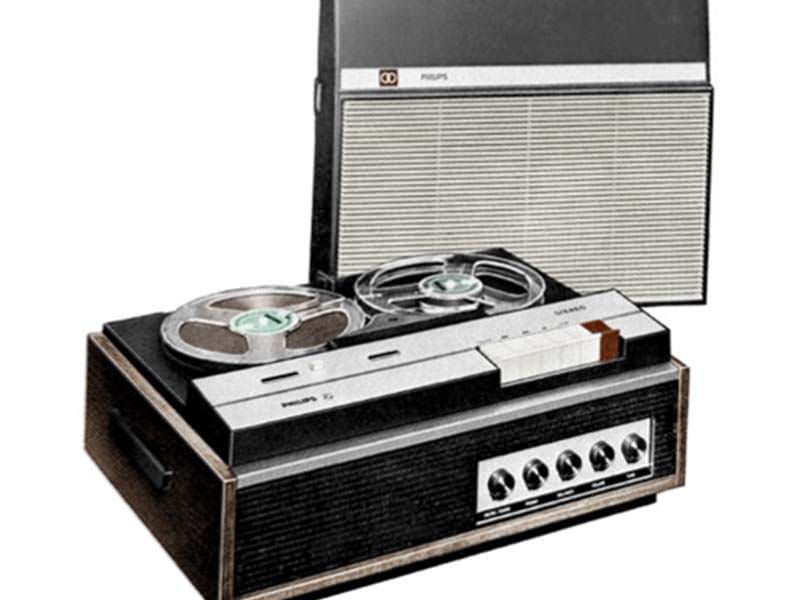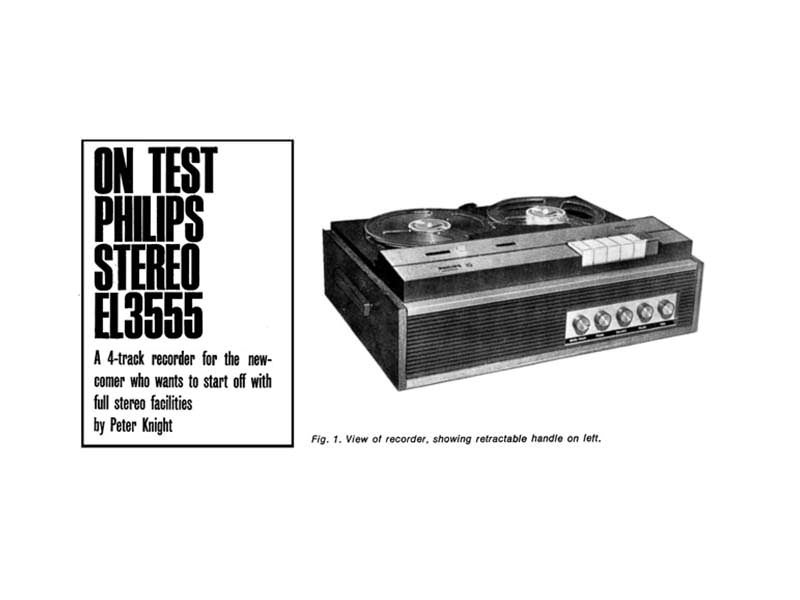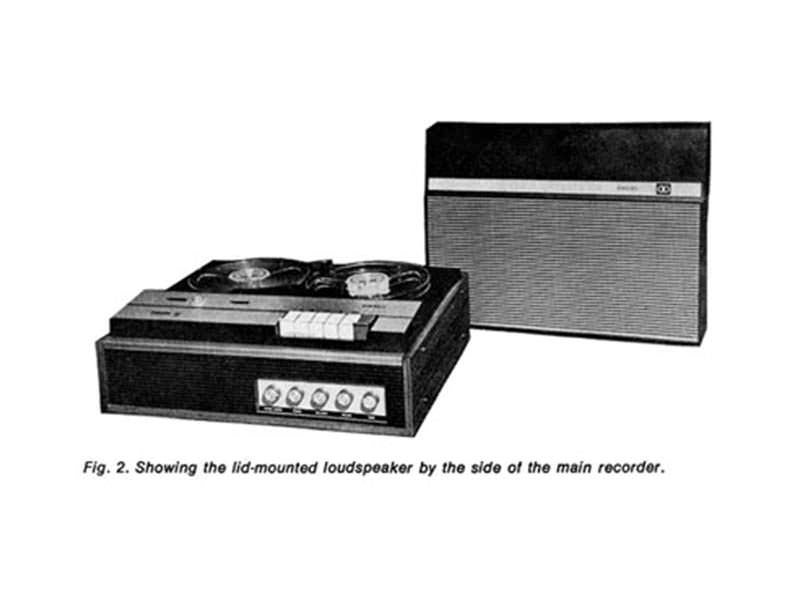Technical Details
Brand: Philips
Model:EL 3555
Category:Vintage
Application:Consumer
Electronics:Hybrid
Equalization:NAB
Country of Manufacture:Netherlands
Release dates:1966 - 1969
Tracks:1/4 Rec/PB
Speeds: 1 7/8, 3 3/4, 7 1/2
Max Reel Size("): 7"
Number of heads: 2
Head Composition: Permalloy
Head Configuration: Stereo
Voltage(s): 100v Japan, 110-120v, 220-240v, Multi
Outputs: DIN
Frequency Response:60Hz to 10KHz at 1 ips and to 15KHz at 3¾ ips. 40Hz to 18KHz at 7½ ips
Wow and Flutter:0.6% peak to peak at 3¾ ips
Signal-to-Noise Ratio:40db
Sound quality rating:6 / 10
Long-term reliability rating: 6/ 10
Additional Details
Description
A quarter-track stereo, three speed recorder intended for domestic use,
the EL 3555 was a hybrid, with solid state preamplifier stages coupled to an ECL82 valve output for each channel and an EM87 magic eye record indicator.
Drive was achieved from a continuous-running capstan with wide flywheel, belt-driven from alternative pulleys for speed change which gave a very good wow and flutter specification.
The placement and marking of controls in three groups of three made operation simple and easily learned.
Read the accompanying vintage test report below for a well-written, informed and
comprehensive description of this piece of equipment.
Additional Info
From Amateur Tape Recording, May 1967
This recent edition from Philips is a four-track, mono/stereo machine with a three-speed tape transport, giving operation at 7½ , 3¾ and 1 7/8 ips. It is mains-operated and designed to work on 100 to 135 volts and 200 to 250 volts at 50Hz (and can be adjusted if required for 60Hz power supplies). It records and plays back stereo. One channel terminates at the ordinary cabinet loudspeaker, while the other stereo channel is catered for on replay by a second matching loudspeaker. This second loudspeaker is built into the lid which is detachable from the top of the machine. Fig. 1 shows the machine with the lid removed and Fig. 2 shows the lid-mounted speaker by the side of the recorder.
A Hybrid
The circuits employ valves and transistors in a hybrid arrangement, with the transistors in the low-level sections where they have an advantage over valves from the noise point of view. The valves are used in the output stages. Each channel features an ECL82 playback output valve giving about 2.4 watts of audio to the speakers, and the design is such that the playback stages can be arranged as a straight-through amplifier for stereo reproduction of programme signals other than those derived from the tape.
The machine is complete for stereo, nothing else to buy, not even a microphone, as a very effective stereo microphone (also suitable for mono) is a part of the equipment. There is also a 7 inch spool of tape and take-up spool. All that is needed to get going is a mains outlet and a matching mains plug. Recording from other sources is also possible, and a lead is provided for this purpose. The complete outfit comes out at £78 15s 0d.
As shown in Fig. 1 , all the control knobs are conveniently grouped together on a panel to the right of the internal loudspeaker grill, while the deck mechanism is under the command of push-keys directly above the group of knobs. The speed-change control lies between the two spools, at the rear of the deck, and edge-type control knobs provide mains on/off, track selection and duo- or multi-play. Tape position is monitored by a four-digit counter with press-to-zero button, and the signal input and output sockets are conveniently grouped together in a cut-out at the rear of the cabinet. There is also a socket to accept a foot-switch control, useful for some commercial (and other) applications. External design is certainly- towards convenience of operation and to make the recorder look attractive the major part of the cabinet is made of teak. The deck top, speaker grill and speaker-mounted lid are all in grey plastic. Nevertheless, the use of timber for the cabinet proper effectively dilutes the ‘plastic effect’, now so much a feature of domestic electronics. The grey plastic is aesthetically set-off against a silver-coloured control panel, knobs and areas along the top of the deck section, and the dimensions of the system as a whole are geared to the latest idea of locating all the domestic entertainment equipment together on wall or shelf units.
For a full-stereo outfit one would expect quite a bit of weight, but the EL3555 only turns the scales at about 28lb. To facilitate transportation, a spring-loaded retractable handle is located on the left of the cabinet, as can be seen in Fig. 1. Weight reduction, of course, is due in part to the use of hybrid circuitry which in turn calls for a smaller mains transformer and power supply circuit, ventilation, space and so on. It is rather curious, however, why the designer decided to employ a triode-pentode valve as the replay output in each channel when there is now an abundance of transistors well able to deliver 2 to 3 watts of low distortion audio. Competitive economics probably represent a factor here, for to fully transistorize would demand, at least, an extra six transistors, possibly eight to avoid the use of coupling and speaker transformers. These, against two relatively inexpensive valves, could put quite a lot extra on the price. At present-day standards, the EL3555 with its extras is excellent value at 75gns.
The press-keys of the deck provide fast-forward and -rewind, replay or record start, stop (canceling all previous programming), record (this is a red key distinguishing it from the other white ones) and pause. This latter key can be pressed to lock the ‘pause’ condition and then pressed again for cancellation. The red record key can be pressed without tape running, thereby allowing the replay section to operate as a straight-through amplifier which also makes it possible to set the recording level prior to starting the tape. An alternative way of handling this is to press the pause key first and then to press the start and record keys together. This allows the recording level to be adjusted, after which the pause control can be unlocked by a second pressing to start the recording on the tape. The keys are easy to operate, but they do need an appreciable amount of downward pressure to lock them on.
DIN Sockets
The rear sockets are all DIN type and they provide outputs for extension right- and left-hand speakers (the internal speakers are disconnected when the extensions are plugged in), input for pick-up, output from headphones, input for signal from radio, amplifier or second recorder (for dubbing, as an example) and output for feeding to a second recorder, input for microphone and input for foot switch. All the appropriate DIN sockets cater for the two stereo channels in accordance with the International Standard (see Matching – Plugs and Sockets in the January 1967 issue).
These inputs are controlled by the front controls, which give recording level for microphone, radio or second recorder, recording level for pick-up, stereo balance, main volume and tone, The two level controls can thus be employed for controlling two separate inputs, thereby providing a built-in mixing facility assuming that the signals for mixing are of the correct level and are from suitable impedance sources. This is where it is useful to know the input sensitivities and output signal levels and the source impedances of a new recorder. Wherever possible, these test reports will include this important information, having in mind that a potential purchaser may wish to integrate the recorder into an existing audio system.
The microphone input is 0.25mV across 2Kohms, the pick-up input being 200mV across 500Kohms (this means that a low-level pick-up could not be connected here direct, though it is possible to load the input from a high-output crystal or ceramic pick-up). In this case some bass loss would occur due to the 500Kohm input, remembering that such pick-ups require a 1 or 2Mohm loading for correct response. Moreover, there is no equalization built in, so this socket is really for accepting signals from a record player, already equalized and amplified from its pick-up, a radio or other recorder or amplifier. These inputs are, of course, duplicated right and left stereo-wise,
The outputs are two at 1V across 50Kohms, two at 200mV across1.5Kohms (for the headphones) and two at 2.3W across 3 to 7 ohms (loudspeakers). The socket for the foot switch is designed to take the Philips switch EL3984/15A, and when connected this acts in the same manner as the pause control key. It is useful for editing, dictation and for trick recordings.
Each channel uses four transistors in an equalized record/replay circuit, and in the replay position the fourth transistor drives the triode-pentode valve. A common transistor hf oscillator synchronizes the bias frequency over the two channels to avoid beat-note troubles. A fluorescent-ribbon recording level indicator (thermionic type) monitors the recording signal simultaneously in both channels on stereo, and as the display from this device is quite bright, it is also useful for indicating when the recorder is switched on. Ht and transistor potentials are obtained from a bridge rectifier fed from a fully isolated winding on the mains transformer. Very elaborate smoothing and filtering cut the hum and ripple output to a very low level.
The circuit design enables the signal being recorded to be monitored in the replay output stages, via the loudspeakers or headphones. The ordinary volume control permits adjustment to the level of the monitored signal, and when loudspeakers are employed acoustic feedback can be troublesome if the microphone is too close to the speakers, and the volume control advanced. This effect, of course, is quite normal.
The tone control is a simple treble-cut arrangement which operates by bringing in a shunt capacitor in the replay channel progressively as the control is rotated. To secure full treble output (see Fig. 3) the control needs to be regulated for minimum top cut. The deck accommodates spools from 3 inch to 7 inch diameter, and the maximum playing time, using a 7 inch spool of double-play tape, is four times 4 hours, 16 minutes. The mechanism runs smoothly and without a great deal of noise, and fast winds of 1,800 ft of tape can be achieved in a little over 3 minutes.
The Stereo Mic
The microphone supplied with the recorder is interesting (Model EL3757/00) in that it is a single-unit stereo model employing two inserts set up at right-angles to each other within the plastic casing. Three little splayed-out legs with contemporary terminations give it a very stable footing on any flat surface. The inserts are medium-to-low impedance dynamic, and they are located in correct orientation by ensuring that the label ‘stereo’ on the microphone casing is pointing at the centre between the sound sources. On mono, the lower of the two inserts is used, and for this application correct orientation is attained by rotating the microphone 45 degrees in the clockwise direction. There is no difficulty in securing full modulation during a recording on one or both microphone inputs, and speaking about 12 inches from the microphone requires an approximate three-quarter setting of the microphone recording level control to give maximum deflection of the fluorescent indicator, at normal speech level. Signal quality is extremely good.
The machine was subjected to a diversity of domestic applications under normal conditions. It was used for ordinary microphone recordings, mono and stereo. Stereo is quite spectacular, especially when replay is by way of a pair of hi-fi loudspeakers or when the output is fed into a stereo hi-fi reproducing system. The internal and lid-mounted speakers reduce the potential to some extent, and the nature of the output stages on replay are not conductive to good quality; but the quality is there (from external amplifier output) if one wants to make use of it. The replay distortion can rise to about 10% towards full replay amplifier output – that is, when the output valves are used. This is not uncommon for this type of single-ended valve output stage. The distortion drops considerably at lower outputs around 0.5W, for instance).
The machine was given to non-technical users for a while, and some interesting tapes of stereo disc dubbing were produced with no apparent problems and from tuition solely from the instruction booklet! The machine was subjected to average domestic usage for a couple of weeks and then tested again in the laboratory.
Power Performance
The 2mV inputs were used for accepting signal from a sine-wave generator matched through a pad, and the extension speaker sockets were loaded accurately to 5 ohms. The machine was set-up for straight-through amplification and the output signal across the 5 ohm loads was monitored on an oscilloscope while at the same time the voltage (rms) was read off an accurate valve-voltmeter, the frequency being at 1,000Hz. The maximum output that could be obtained up to the onset of waveform clipping was 2 watts both channels pretty well equal). This was checked on an Avo audio watt-meter – still 2 watts across 5 ohms. Other load values were tried, but 5 ohms appeared to yield the most power.
The machine was then programmed for taking a 7½ ips recording from the sine-wave generator (inputs as before). Lengths of recording at frequency intervals over the spectrum were made at a maintained constant input signal level, and the recording level control was set for full deflection of the indicator at the frequency over the spectrum giving maximum deflection (this was in the region of 19KHz). The sine-wave recordings so produced were played back while the extension speaker outlets were monitored with a watt-meter and oscilloscope as before. Again maximum output 2 watts at 1,000Hz. At that same power in the 100Hz region the waveform was severely distorted, distortion gradually reducing towards about 500Hz, with a small amount of distortion at 1,000Hz.
The power output under these conditions was then plotted over the spectrum. and the curve shown in Fig. 3 was obtained. This was almost identical on the other channel. This is, nevertheless, quite a reasonable overall power response curve, and although the oscilloscope indicated high distortion at low frequencies this was not unduly discernible under normal conditions of working; in any case, the machine would never partner a hi-fi outfit with the output valves in circuit. The far better quality from the ‘diode’ outputs, for instance, would be exploited.
On the whole, this new Philips stereo model is a very interesting machine, and it is the kind of recorder that will appeal to the enthusiast bent on changing from mono to stereo or to the tape beginner desirous of launching straight into stereo with the least possible outlay. Its versatility makes it of particular value to the enthusiast already in possession of a quality stereo radio and disc reproducing outfit now desirous of adding tape in such a way that the recorder can be used independently on both mono and stereo. At 75gns it is good value for money.
Maker’s Specification
Four-track mono/stereo with facilities for duo- and multi-play. Three speeds, 7½ , 3¾ and 1 ips .
Frequency response: 60Hz to 10KHz at 1 ips and to 15KHz at 3¾ ips. 40Hz to 18KHz at 7½ ips all within 6dB). Spool sizes: 3 inch to 7 inch. Maximum audio power output per channel: 2.3 watts across 5.6 ohms. Power input: Approximately 75W. Inputs: For radio, record player, second tape recorder, microphone, etc. Two mixing controls featured. Outputs: External speakers, headphones and high-level across 50K ohms. Dimensions: 17½ x 13¾ x 8½ inches. Weight: Approximately 28 lb.
Valve complement: 2 x ECL 82 (output) and EM 87 magic eye, solid state preamplifiers / Rewind speed: 1,800 ft of tape in a little over 3 minutes / Audio output power: 2.3 watts across 5.6 ohms. / Inputs: radio, second tape recorder, record player 200mV across 500Kohms, microphone 0.25mV across 2Kohms / Outputs: external speakers, headphones and high-level across 50K ohms / Speaker(s): 2 – one in cabinet and one in detachable lid / Dimensions: 17½ x 13¾ x 8½ inches (445 x 349 x 216 mm) / Weight: 28 lbs (12.7 kg) / quarter-track mono




